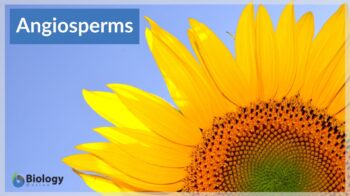
Angiosperm
n., plural: angiosperms
[ˈændʒɪəˌspɜːm]
A flowering, fruit-bearing plant or tree known for having ovules (and therefore seeds) develop within an enclosed ovary
Table of Contents
Angiosperms Definition
What is an angiosperm? An angiosperm is a plant that produces flowers. The angiosperms, also identified as the flowering plants, belong to one of the vital groups of plants having seeds. The word angiosperm has been derived from a couple of Greek words where angeion stands for “vessel” and sperma means “seed”.
Angiosperms belong to one of the most diverse and largest extant groups of plants found in the universe. There are approximately 453 families of angiosperms that contain around 260,000 living species classified in them. Moreover, around 80 percent of all known green plants living on the earth are represented by angiosperms (Manjunatha et al., 2019). It is very well elaborated that the vascular seed plants in which an egg is fertilized and developed into a seed in an enclosed hollow ovary are angiosperms.
The seed of angiosperms, unlike gymnosperms, such as conifers and cycads, are found in the flower. In gymnosperms, the seeds are borne exposed to the bodies and surfaces of the reproductive parts for example cones. Furthermore, both male and female organs can easily be found in the flowers of angiosperms.
The angiosperms occupy nearly every habitat located on the earth except the environments that bear extreme climatic conditions such as uppermost mountain ranges, the deepest blue oceans, and the regions that are present and surrounding the poles. They can be found as epiphytes (living on various other plants), floating on the surfaces of surface waters, rooted in freshwater and marine habitats, and terrestrial plants that vary in dimensions.
Angiosperms can be seen as tiny herbs, parasitic plants, vines, and gigantic trees and they range in small millimeters as tiny floating plants to large trees that are over 100 meters tall. It is worth mentioning here that, massive diversity can be found in the chemistry, reproductive cycles, morphology, anatomy, and sizes of the angiosperms as compared to the other members and species in the Plant Kingdom.
The most diverse families of flowering plants compared with the number of species are elaborated in Table 1. The most common and diverse species of angiosperms are Orchidaceae that belong to the orchid family followed by the daisy, pea, and grass families.
Table 1: Name, Family, and Species of popular Angiosperm Plants
| S. No. | Name of Flowering Plant | Family | Species |
|---|---|---|---|
| 1. | Orchidaceae | Orchid Family | 25,000 |
| 2. | Asteraceae or Compositae | Daisy Family | 20,000 |
| 3. | Fabaceae or Leguminosae | Pea Family | 17,000 |
| 4. | Poaceae or Gramineae | Grass Family | 9,000 |
| 5. | Rubiaceae | Madder Family | 7,000 |
| 6. | Euphorbiaceae | Spurge Family | 5,000 |
| 7. | Malvaceae | Mallow Family | 4,300 |
| 8. | Cyperaceae | Sedge Family | 4,000 |
| 9. | Araceae | Aroid Family | 3,700 |
The angiosperms are extremely vital to support the existence of the living species as the majority of the crops that are cultivated to satisfy the nutritious needs of the living are angiosperms. Similarly, their other applications can be found in producing medicines, fibrous products, timber, ornaments, and various other commercial products.
Angiosperm Anatomy and Morphological Features
With reference to the definition and background of the angiosperm plants elaborated above, many scientists describe them as “flowering” plants and classified them into a single phylum: the Anthophyta. Their floral anatomical parts include pollens, stamens, and/or carpels.
The sperm of the flowering plants are pollen grains that are produced by stamens. The pollen grains contain the male gametes that may react with the female gametes (ova) in the ovaries of the plants. These gametes enable angiosperms to reproduce sexually. (Note: apart from sexual reproduction, angiosperms may also carry out certain forms of asexual reproduction, e.g. vegetative propagation and apomixis.)
The pollen grains in the angiosperms are smaller in size than the pollen found in the gymnosperms, hence the reduced size aids the process of fertilization by reaching the female eggs in less time. It is often seen that some families of the angiosperms reproduce without being fertilized or in other scenarios, by using their own pollen they can fertilize themselves. Hence, the stamens play a very crucial role in the fertilization cycle of flowering plants.
The flowers after stamens and pollens are the next very important part of the anatomy of the angiosperms and they are referred to as the structure where both male and female reproductive parts of the angiosperms can be found. The flowers are designed in such a way that they may attract insects and other mammals for the cross-pollination process. It can be seen in various plants that the flowers are colorful and have pleasant smells.
The ovaries, behind the flowers of the plants, are enclosed in the carpels. The ovaries in the angiosperms can receive the pollen and can start the process of producing seeds, flowers, and fruits more swiftly as compared to gymnosperms. If the whole process of the development of the plant can be observed carefully, it can be concluded that the fruit is developed from the flower after pollination and this is the prime responsibility of the carpels. The detailed anatomy of the flower as one of the angiosperms’ characteristics is shown in Figure 1.
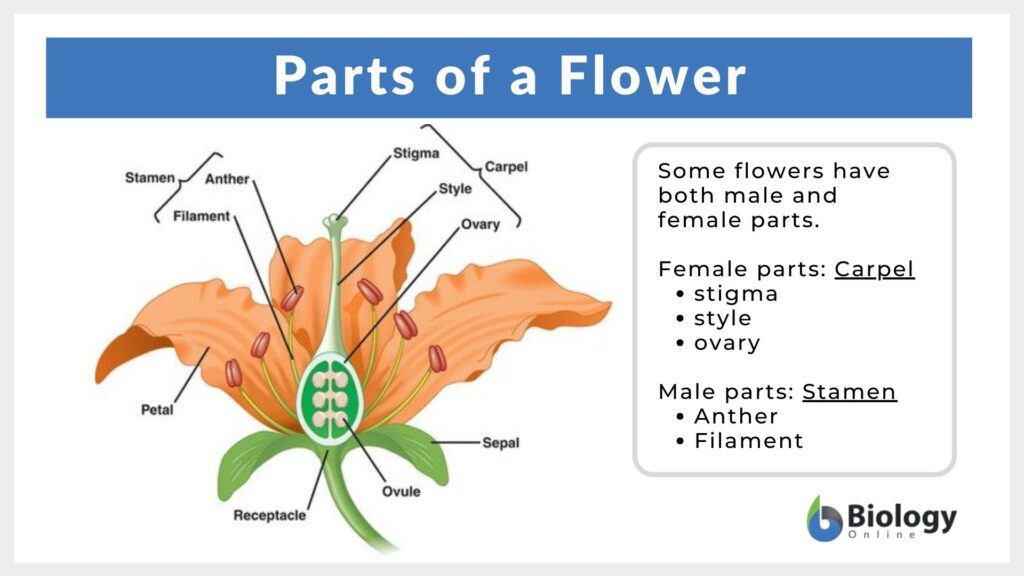
The angiosperms, despite their diversity, are united by shared and derived features collectively known as synapomorphies. Some of the vital angiosperms characteristics are that the ovules are present in the carpels, which is a structure that is made up of ovary and the ovules are enclosed in it and the process of pollination occurs here. Secondly, a cycle of double fertilization occurs which leads to the formation of endosperm and there are three stamens that have a couple of pollen sacs. Finally, the angiosperms have phloem tissues that are mainly composed of sieve tubes and companion cells. Hence it can be concluded that the extent of angiosperms occurred from various origins instead of one.
Angiosperm flowers and pollination
The process of pollination is very important in the process of angiosperms reproduction. Stamens are the male sex organs in the angiosperms while the pollens are formed in the stamen of the plant. The pollen produced in the stamen of the plant has to be transferred to the pistil that is the female part of the plant. The process by which the pollen is successfully transferred from the male part of the plant to the female part is known as pollination. Self-pollination and cross-pollination are the two forms of pollination. The agents of pollination include wind, insects, invertebrates, and other mammals (Kooi and Ollerton, 2020).
The basic structure of Angiosperms
While flowers are the reproductive organ, the non-sexually-reproductive body parts are roots, stems, and leaves. The two main parts of the structure of the angiosperm are root systems and shoot systems. The part of the plant present above the soil is called the shoot system whereas the part of the plant that lies under the soil is the root system. The roots come under the domain of root systems while the leaves and stems come in the shoot system of the plant (Figueroa-Bustos et al., 2018). The basic structure of the plant is shown in Figure 2.

Root systems
The vital responsibility of the root is to anchor the plant, absorb water and minerals from the soil, and provide them to the tip of the plant. Root systems are classified into further two categories that are primary root systems and tertiary root systems. The primary root systems are the most common types of root systems that consist of a taproot that is the primary root of the plant. The taproot root grows vertically downward and from its various smaller lateral roots are originated that either can grow horizontally or diagonally. Thus, many secondary roots of relatively fewer dimensions are produced from the taproots. The main difference between the primary and tertiary root systems is that in the later system the primary root is a very short spanned root and the life of it is very small. Therefore, it is replaced by supplementary root systems. Currently, the primary and tertiary roots are modified as per the need and nature of the plants. Carrots and beets are some of the common examples of such systems. Meanwhile, the important and independent parts present in both root and shoot systems have been marked in the figure.
Stem systems
The main part of the plant that is the aerial axis in nature and bears the leaves and flowers is called the stem. The stems conduct water and minerals from the roots and supply them directly to the leaves, flowers, and plants. The stem of the plant is connected to the root systems for the continuous flow of nutrients via a transition region known as hypocotyl. The area where the leaves are attached to the stems are called nodes and internodes are the regions that lie in between two successive nodes. Axillary and dichotomous are the two forms of branching in angiosperms whereas the monopodial and sympodial are the two common modes of axillary branching. Many different tree architectures have been evolved by the combination of monopodial and sympodial branching in a single plant.
Leaves
Leave is another vital part of the flowering plant. The leaf base, stipules, petiole, and blade also referred to as lamina are the major parts that make the structure of the leaf. The paired stipules are present on each turn of the leaf base while the blade and the leaf base are connected via petiole. The process of photosynthesis occurs on the surface of the blade and thus it appears flattened and green in most of the plants. It should be noted that many leaves lack petiole whereas there are many in which stipules are missing. Hence, the basic construction of a leaf varies from one plant to another depending on its functionality. Also, alternate, opposite, paired, and whorled are some of the patterns of the leaf arrangement present on the stems in angiosperms.
Reproduction and life cycle of Angiosperm
It has been well elaborated in the above discussion that the angiosperms are the seed-producing plants and that generate female and male gametophytes that give them permission to carry out the double fertilization process.
The main phase in the life cycle of angiosperm is the adult phase also referred to as the sporophyte. However, angiosperms are heterosporous. Hence, the microspores are generated, which will produce the pollen grains termed as gametophytes that are male ones. Secondly, the megaspores will form the ovules where female gametophytes are present. It should be noted here that in each pollen grain there are a couple of cells. Among the two cells, one is the generative cell that will be divided into two sperms and the pollen tube will be originated from the second cell.
The megasporangium that is present in the ovule is protected by the ovary wall. In megasporangium, the process of meiosis occurs and three small and one large megaspores are produced. However, among them, only the large megaspore survives and transforms into the embryo sac and the eight-cell stage is formed after the megaspore gets divided thrice. From here, the process of migration of cells starts, and four of the eight cells move towards the embryo sac pole while a couple of them come to the equator thus forming a 2n polar nucleus. The anatomy of a mature embryo sac has a single egg sac, a couple of helping cells known as synergids, three antipodal cells, and a couple of nuclei in the center of the cell. A pollen tube is extended from the cell, once the pollen grain arrives at stigma. Hence, in the embryo sac, the two sperm cells are deposited (Dilcher and Zimmermann, 2019).
After the sperm cells are deposited on the embryo sac the process of double fertilization is started and the future embryo is formed by the combination of an egg and single sperm. On the other side, the endosperm is formed, after the fusion of the second sperm with the 2n polar nuclei. The endosperm is the tissue where the food is reserved. Additionally, monocots and dicots are developed from the zygote.
The two major groups of angiosperms, the monocots and the eudicots, are the basis of the differences in the number of embryonic leaves. Similarly, seed leaves in the form of lipids, proteins, and carbohydrates are stored on the surface of the embryo. The broken-down food reserves are supplied to the developing embryo from storage sites via cotyledons.
The angiosperms are divided into three species that are hermaphroditic (pistils and stamens are on the same flower), monoecious (stamens and pistils are on the different flower but over the same plant), and finally dioecious (both stamens and pistils are found in different flowers in different plants).
The complete life cycle with independent stages is shown in Figure 3.
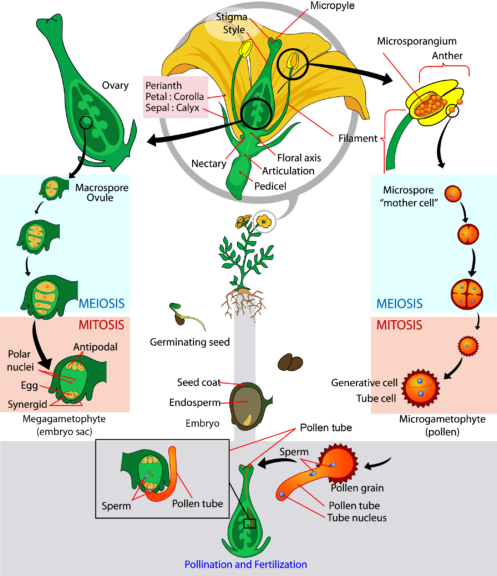
ANGIOSPERM REPRODUCTION – VIDEO
LIFE CYCLE OF ANGIOSPERM – VIDEO
Distinctive features of Angiosperms:
- The reproductive organs in the flowers of these plants enable them to utilize a more species-specific breeding system.
- They have stamens that bear pollen. This feature enables certain Angiosperms to prevent self-fertilization while increasing the odds of fertilizing another flower of the same or of a different plant. This helps increase genetic variability.
- They have smaller male and female gametophytes in comparison to those of other seed-bearing plants, i.e. gymnosperms.
- They have a closed carpel enclosing the ovules. The carpel(s) and other accessory parts may develop into a fruit, which is an important plant organ for seed dispersal.
- They form endosperm, which is a nutritive tissue for the developing embryo or for the seedling.
Monocot: distinctive features
The plants that are present in the monocots are identified by the existence of the only cotyledon in the seedlings. Monocots as a group were first identified by Ray in 1703. Moreover, this grouping has been supported by various nonmolecular phylogenetic studies made in the late 19th century, and thirteen other putative synapomorphies were identified. The veins running parallel to the length of the leaves and the arrangement of the flower parts in three- or six-fold symmetry are some of the other important anatomical features present in the monocots. It has been observed that in monocots, the true woody tissues are rarely found. It has been explored that in the very first angiosperms, the pollen grains were monosulcate, consisting of a single furrow throughout the layer and this salient feature is still quite evident in all modern monocots. True lilies, grasses, orchids, and palms are some of the most commonly seen plants that are present in the monocots whereas rice, cereals, corns, sugar cane, bananas, and pineapples are some of the very important and extensively utilized monocot crops.
Dicot: distinctive features
Dicots also referred to as eudicots consist of a couple of cotyledons in the developing shoots. In the leaves of dicots, a broad network is formed by the veins however the flower part can be seen in four or five parts. In dicots, the ring is formed in the stem by the vascular tissues contrary to monocots, where the vascular tissues in the stem are scattered. Moreover, dicots can be herbaceous in nature or can produce woody tissues. A triporate or trisulcate pollen is formed by the majority of the eudicots with three pores while nearly two-thirds of all the flowering plants are found in the universe as dicots. Cabbage, beans, and peaches are some of the most common dicots that are consumed by living organisms to satisfy their energy demands.
For a comparison of the characteristics of monocots and eudicots, see this table below.
Table 2: Monocots vs. Eudicots
| Monocots | Eudicots |
|---|---|
| One cotyledon | Two cotyledons |
| Leaf: parallel venation | Leaf: network or reticulate venation |
| Scattered vascular bundles in the stem | Vascular bundles are arranged in a ring pattern in the stem; many dicot stems have secondary growth |
| Fibrous root system | Taproot system |
| Monosulcate pollen | Trisulcate pollen |
| Trimerous, meaning floral parts are three or of multiples of three | Four, five, or multiples of four or five and whorls |
| Examples: palms, grasses, orchids, and lilies. | Examples: beans, buttercups, oaks, and sunflowers. |
Diversity of angiosperms: the diversity of the angiosperms is classified into two major categories that are monocots (monocotyledonous plants) and eudicots (dicotyledonous plants, or simply dicots) based primarily on the number of cotyledons that can be found in them. Generally, the lilies and grasses are found in monocots and polyphyletic groups are placed in the dicots.
Angiosperms Examples
There are many angiosperms examples that can be seen in daily life. From fruits to grains and vegetables to flowers the impact and examples of flowering plants are massive for the existence and survival of living organisms. The fruit trees are the most common examples of angiosperms. There are various kinds of flowers that appear on the branches of fruit trees before they are converted into fruits such as apples, oranges, and cherries. These trees are pollinated by various insects and mammals. Once the process of attracting the pollinators is over, the carpel of the plant starts swelling and thus ultimately gets converted into fruits, and perhaps it may change colors too.
Grasses and grains are also angiosperms. It is a common observation that grass crops such as wheat and rice are unable to attract animals for pollination and hence, they rely widely on the wind. The seeds of the grasses are very light and can be easily spread by wind. Other examples of flowering plants are vegetables and flowers. It can be assumed from the above discussion that the angiosperms are very crucial in the existence of humans and the majority of the crops are all angiosperms (Dilcher and Zimmermann, 2019).
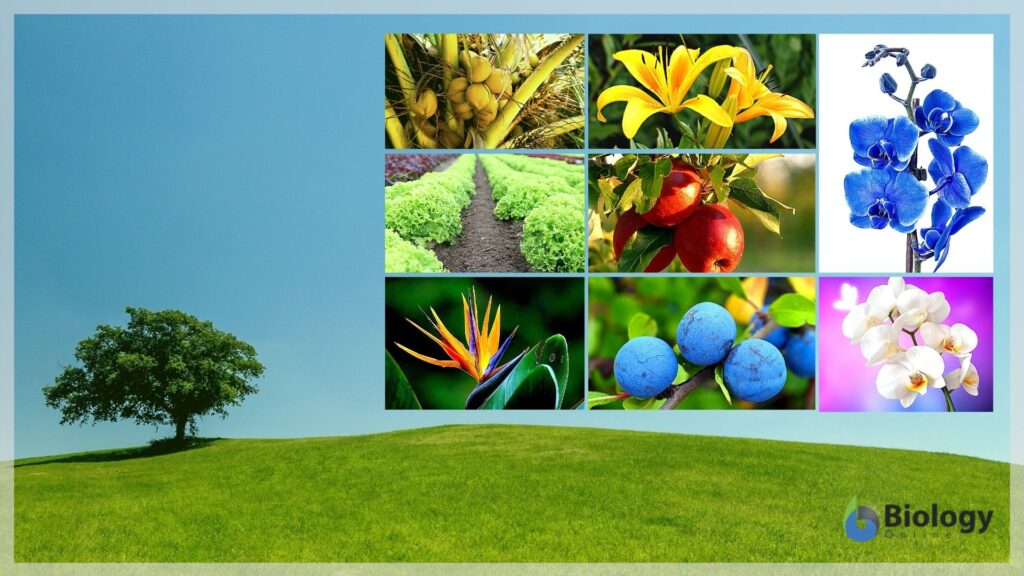
Evolutionary History of Angiosperms
The massive appearance, evolutionary history, and diversification of the angiosperms can be seen via undisputed fossil records in the middle to the late era of the Mesozoic. Angiosperms are referred to as flowering plants (Angiospermae, or Magnoliophyta) that consist of both male and female reproductive structures. The fossil evidence explored by the Paleontologists suggests that the flowering plants initially appeared about 125 million years ago in the Lower Cretaceous, and were diversified around 100 million years ago in the middle Cretaceous. The very early traces to be found of the angiosperms are very scarce. The pollen fossils that have been recovered from the geological material from the Jurassic have been ascribed to the angiosperms. The imprints of the leaves that appeared on the fossil records of the cretaceous rocks are said to have a close resemblance to the angiosperms.
There are several hypotheses that have been developed to understand the profusion of the flowering plants but still, the paleontologists are busy justifying their rapid developments. The botanists believe that although the angiosperms are derived from gymnosperms but still, they form their own distinct species. The paleontologists are still debating that either the small woody bushes are the origin of the angiosperms or they evolved from the tropical busy grasses.
The most initial living flowering plant is said to be Amborellatrichopoda, which is a very small plant that was found in the rain forests of New Caledonia, which is a small island of the South Pacific. The research confirmed that Amborellatrichopoda can be related to the existing species of the flowering plant and is the oldest branch of the angiosperms. Basal angiosperms are also among few other species of angiosperms but they branched off early from the phylogenetic trees. Most of the modern angiosperms are either classified as monocots (single seed leaf) or eudicots (two seed leaf) based on the structure of their leaves, embryos, and fruits. The phylogeny of the early angiosperms has been shown in Figure 5 indicates the unranked groups of angiosperms (Tang et al., 2014).
Fossil records of Angiosperms
The most ancient fossil records of angiosperms can be found nearly 132 million years ago. In the early angiosperms, the structure, floral size, and organization varied tremendously in the dimensions of the flowers ranging from less than 1 cm to relatively larger sizes. However, some of the early fossils found have no close extant relatives such as Archaefructs but the floral diversity found in the fossil records of angiosperms is very consistent with the early radiation of angiosperms and diversification of the floral forms (Soltis et al., 2005).
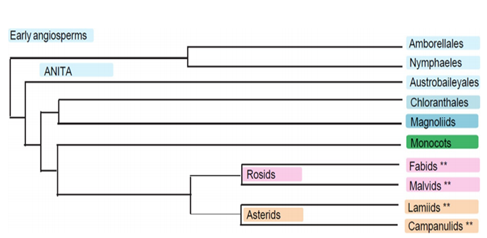
EVOLUTION OF ANGIOSPERM – VIDEO
Age estimates of Angiosperms
The estimation of relative ages of the angiosperms and the time frame when the important divergences occurred in them based on the molecular data has been done via results obtained from fossil fuels. However, the most recent efforts to estimate the origins of the flowering plants by using the molecular data and improved dating methods have converged on the estimation of 180-140 mya and the dates have been predicted over the range of 5 to 45 million years. In the study conducted by Charles D Bell et al, the authors predicted the age of various angiosperms and the divergence times by using 36 calibration times for 567 taxa. Based upon the methodology the botanists followed, the angiosperms had an estimated age of 167-199 Ma. The researchers also published that the relative ages of me Angiospermae, Gunneridae, Rosidae and Asteridae were 139-156 Ma, 109-139 Ma, 108-121 Ma, and 101-119 Ma respectively [8].
Taxonomy of Angiosperms
The taxonomy of the angiosperms is the law that governs the classification of plants and is the center of the research by many botanists. The latest classification system, which is massively based on the comparative data, extracted from the studies of DNA sequences, is known as the Angiosperm Phylogeny Group IV (APG IV) botanical classification system. The Angiosperm Phylogeny Group IV system was established by a group of botanists working from various natives and research institutes and was based on the knowledge from various phylogenetic studies. The angiosperms are placed as a group in clade Anthophyta.
Ecological Importance of Angiosperms
Angiosperms provide an important source of food for both animals and other living organisms as they are a vital component of the terrestrial environment in terms of biomass and the number of individuals. The carbon-containing compounds, especially carbohydrates, are used to synthesize the cellular structures of plants and to fulfill their metabolic and nutritionist needs. Moreover, they are the source of energy for many heterotopic organisms as well. The solar energy is stored in the tissues of the plant after converting into chemical energy and then the energies are transferred into herbivores as they consume plants and then for herbivores to carnivores and thus the food chains go on. In many temperate forests, the feed of thousands of animals (birds, insects, and mammals) is satisfied by a single angiosperm tree. Hence, angiosperms are very important to the ecological web and food chain.
The impact of flowering plants in managing the food chain can never be denied. The vegetative parts of the plants are consumed by a vast variety of insects and invertebrates. Flowers, fruits, and seeds are a source of energy for many animals. Many pollinating insects such as bees need pollen that can only be provided via angiosperms. Similarly, the living and reproduction cycle of bats, birds, and mammals depend on the energy they get after consuming the fruits available on the flowering plants. Moreover, small rodents and birds consume the seeds and they usually carry the seeds and fruits of various flowers with them that indeed propagate the angiosperm. Another useful advantage of angiosperms is that various secondary compounds such as oils, glycosides, and alkaloids are produced through them. Hence, they protect many plants from foreign invasions of herbivores by forming toxic secondary plant compounds.
Economic Importance of Angiosperms
Another economical advantage of angiosperms is that they provide various pharmaceuticals. Apart from some of the antibiotics that are manufactured vary in compositions, almost all of the medicines are either derived and extracted directly from the angiosperms or if synthesized, their major components are found in angiosperms. The list of medicines includes vitamins, aspirin, narcotics, and quinine. There are certain angiosperms that are extremely toxic to livings have proved to be very effective in the treatment of cancer, leukemia, and several heart problems. Quinine is used to treat malaria, vincristine is used to treat leukemia, curare for muscle relaxants in open-heart surgeries, and diosgenin is used as a precursor in oral contraceptives. The contribution of angiosperm in maintaining our habitat is extremely vital. The variety of food resources and oxygen supply in our habitat is strongly dependent on the versatility of angiosperms found. A significant loss in the number of angiosperms will have a huge impact on the survival of our habitat.
Angiosperms and Gymnosperms
The angiosperms and gymnosperms are both types of plants but they differ from each other in many ways. The angiosperms are the flowering plants such as fruits, grains, and vegetables whereas all kinds of pines, fir, cedar, juniper, cypress that indeed are all non-flowering plants come in gymnosperms. The angiosperms accumulate to form flowered while cones are produced via accumulation of gymnosperms whereas the angiosperms are mostly bisexual and occasionally unisexual and the latter are generally unisexual and rarely bisexual. The structural differences between both of them include the presence of sepals, petals, stigma, and styles in the flowering plants. Moreover, in angiosperms the ovules are produced on the stalk and archegonia is absent where in gymnosperms the ovules are sensible and the distinct archegonia are present. The major difference again in both of them is the presence of the various numbers of cotyledons. Lastly, both kinds of plants have their domestic uses. The angiosperms are the primary source of hardwoods worldwide and are economically vital as the source of pharmaceuticals, timbers, ornaments, and fiber production while the softwoods are supplied by gymnosperms such as pine fir and thus, they are used to produce paper, lumber, and plywood.
ANGIOSPERM VS GYMNOSPERM – VIDEO
Conclusion
It can be concluded from the above discussion that angiosperms belong to one of the most diverse and large extant groups of plants found in the universe and the flowering plants that play a very vital role in the survival of living organisms. Around 80% of the available plants in the universe are represented by angiosperms. The angiosperms evolved around 200-250 million years ago and quickly gained advantages over gymnosperms. The anatomy of angiosperms states that these plants include stamens, pollens, flowers, and carpels. The most common examples of angiosperms are fruits, grains, vegetables, and flowers. The angiosperms despite their diversity are united by shared and derived features collectively known as synapomorphies. The most ancient fossil records of angiosperms can be found nearly 132 million years ago.
The basic body of angiosperms has mainly these parts: roots, stems, leaves, and flowers, and the two main parts of the structure of the angiosperm are root systems and shoot systems. The vital responsibility of the root is to anchor the plant, absorb water and minerals from the soil, and provide them to the tip of the plant. Root systems are classified into further two categories that are primary root systems and tertiary root systems. The main part of the plant that is an aerial axis in nature and bears the leaves and flowers is called the stem. The stems conduct water and minerals from the roots and supply them directly to the leaves, flowers, and plants. Leave is another vital part of the flowering plant. The leaf base, stipules, petiole, and blade also referred to as lamina are the major parts that make the structure of the leaf.
The diversity of the angiosperms is classified into two major categories that are monocots and dicots. Generally, the lilies and grasses are found in monocots and polyphyletic groups are placed in the dicots. Dicots also referred to as eudicots consist of a couple of cotyledons in the developing shoots while in monocots there is only a single cotyledon. Cabbage, beans, and peaches are some of the most common dicots whereas true lilies, grasses, orchids, and palms are some of the most commonly seen monocots. Angiosperms provide an important source of food for both animals and other living organisms as they are a vital component of the terrestrial environment in terms of biomass and the number of individuals. The impact of angiosperms in managing the food chain can never be denied. The vegetative parts of the plants are consumed by a vast variety of insects and invertebrates. Another economical advantage of angiosperms is that they provide various pharmaceuticals. Hence, it can be concluded that the contribution of angiosperm in maintaining our habitat is extremely vital.
Try to answer the quiz below to check what you have learned so far about angiosperms.
Further Reading
References
Bagdane, K.K. (2020). Taxonomy of Angiosperms and Plant Ecology-BOTANY PAPER I (Old pattern 2013). http://econtent.unipune.ac.in:8080/xmlui/handle/123456789/7642
Bell, C. D., Soltis, D. E., & Soltis, P. S. (2010). The age and diversification of the angiosperms re-revisited. American Journal of Botany, 97(8), 1296–1303. https://doi.org/10.3732/ajb.0900346
Dilcher, D.L. and Zimmermann, M.H. (2019). Angiosperm.
Figueroa-Bustos, V., Palta, J., Chen, Y., & Siddique, K. (2018). Characterization of Root and Shoot Traits in Wheat Cultivars with Putative Differences in Root System Size. Agronomy, 8(7), 109. https://doi.org/10.3390/agronomy8070109
Haibao Tang, E. Lyons, & Schnable, J. C. (2014). Early History of the Angiosperms. Undefined; https://www.semanticscholar.org/paper/Early-History-of-the-Angiosperms-Tang-Lyons/de605e8cfe4e9804637f61df6e4fa025e1060f96
Manjunatha, S., Devabrath Andia, J., et al. (2019). DIVERSITY OF ANGIOSPERMS IN THE KUKKARAHALLI LAKE, MYSURU, KARNATAKA, INDIA. Plant Archives, 19(2): 3555-3564.
Pam, S., Soltis, D. and Edwards, C. Angiosperms. (2005). Flowering Plants. http://tolweb.org/Angiosperms/20646
van der Kooi, C. J., & Ollerton, J. (2020). The origins of flowering plants and pollinators. Science, 368(6497), 1306–1308. https://doi.org/10.1126/science.aay3662
©BiologyOnline. Content provided and moderated by BiologyOnline Editors.



